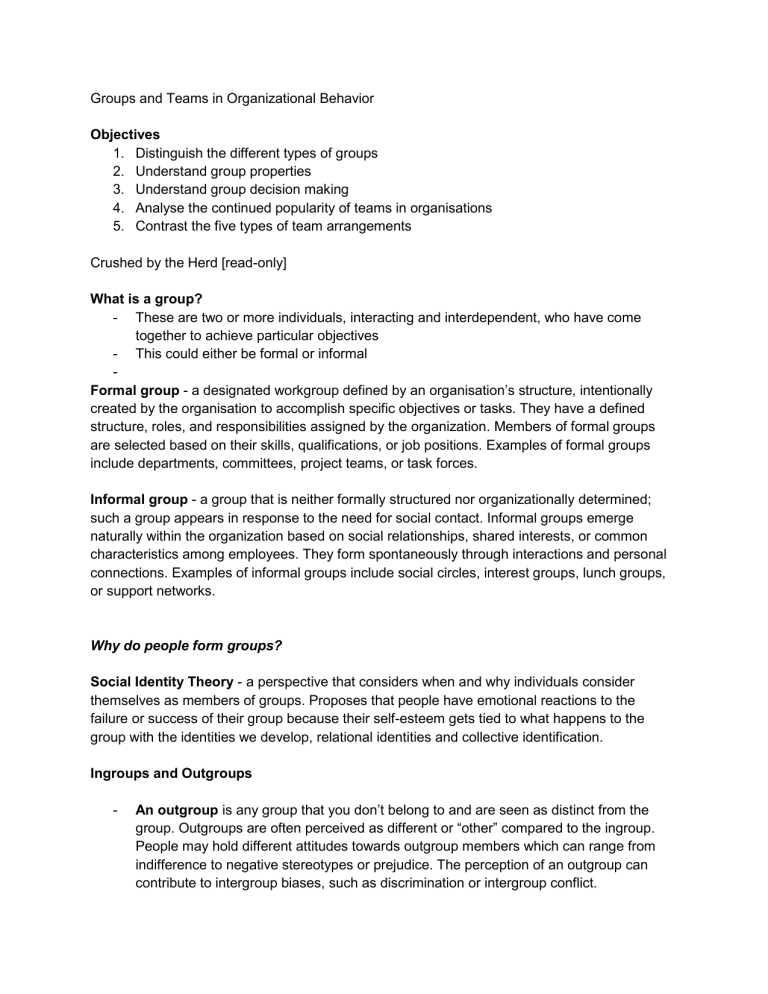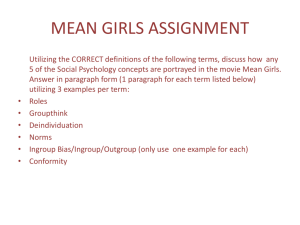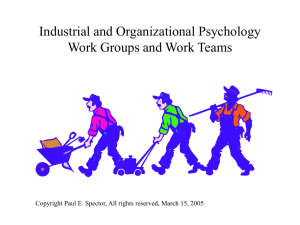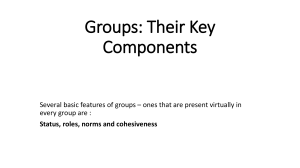
Groups and Teams in Organizational Behavior Objectives 1. Distinguish the different types of groups 2. Understand group properties 3. Understand group decision making 4. Analyse the continued popularity of teams in organisations 5. Contrast the five types of team arrangements Crushed by the Herd [read-only] What is a group? - These are two or more individuals, interacting and interdependent, who have come together to achieve particular objectives - This could either be formal or informal Formal group - a designated workgroup defined by an organisation’s structure, intentionally created by the organisation to accomplish specific objectives or tasks. They have a defined structure, roles, and responsibilities assigned by the organization. Members of formal groups are selected based on their skills, qualifications, or job positions. Examples of formal groups include departments, committees, project teams, or task forces. Informal group - a group that is neither formally structured nor organizationally determined; such a group appears in response to the need for social contact. Informal groups emerge naturally within the organization based on social relationships, shared interests, or common characteristics among employees. They form spontaneously through interactions and personal connections. Examples of informal groups include social circles, interest groups, lunch groups, or support networks. Why do people form groups? Social Identity Theory - a perspective that considers when and why individuals consider themselves as members of groups. Proposes that people have emotional reactions to the failure or success of their group because their self-esteem gets tied to what happens to the group with the identities we develop, relational identities and collective identification. Ingroups and Outgroups - An outgroup is any group that you don’t belong to and are seen as distinct from the group. Outgroups are often perceived as different or “other” compared to the ingroup. People may hold different attitudes towards outgroup members which can range from indifference to negative stereotypes or prejudice. The perception of an outgroup can contribute to intergroup biases, such as discrimination or intergroup conflict. - An ingroup is a group that you associate yourself with and perceive themselves as belonging. An ingroup provides a sense of belonging, social identity and self-esteem. People tend to have positive attitudes towards their ingroup and exhibit favouritism or bias towards group members. - An in-group favouritism is perspective in which we see we see members of the ingroup as better than other people and people not in our group as all the same. The foundations of group behaviour (what are the different group properties?) 1. Role - - - A set of expected behaviour patterns attributed to someone occupying a given position in a social unit. An example is a group consisting of 4 members with each unique role to fulfil a software development project. A lead developer, a quality assurance specialist and a graphic designer. These specific roles are distinct and specific outlining the responsibilities and expectations associated with the position. Role perception is an individual’s view of how he is supposed to act in a given situation Role expectations are how others believe a person should act in a given situation with psychological contracts being unwritten arrangements that set out what management expects from an employee and vice versa. Role conflicts are situations in which an individual is confronted by divergent role expectations. An interrole conflict is a situation in which the expectations of an individual’s different separate groups are in opposition. 2. Norms - These are acceptable standards of behaviour within a group that are shared by the group’s members. Group roles are ground rules that can encourage a group to work efficiently and discourage behaviours that hinder its effectiveness. - Despite being unwritten, they govern how group members interact with each other, work as a team and even how they dress. - A good example is a sales team with norms of shared expectations and standards of behaviour such as expectations to promptly follow up leads generated through marketing efforts, specified time frames, the importance of consistency within the group and collaboration is encouraged which may benefit customer satisfaction, team cohesion and improvements in sales performance. 3. Status - A socially defined position or rank given to groups or group members by others. - To determine status, we use the Status Characteristics Theory, a theory that states that differences in status characteristics can create status hierarchies - within groups. The sources of such characteristics are the power a person wields over others, the ability to contribute to a group’s goals and personal characteristics. For example, let's say you are an Executive Vice President, which is a senior leadership role in an organization, making key organizational decisions, and driving corporate goals with strategic direction. This position grants an individual significant influence with the ability to shape policies, allocate resources and guide the overall direction of the organization. This is a highly regarded position within the organization that often comes with respect from colleagues, subordinates and external stakeholders. Often compensated with high salaries, additional perks and benefits compared to lower-level positions. 4. Size and Dynamics - Smaller groups tend to develop cohesion more quickly while being more productive for the completion of a particular task - Bigger groups are more effective for problem-solving, however, social loafing may occur when there are more numbers in a group, leading to less individual effort and the individual becomes a free rider. 5. Cohesiveness - The degree to which group members are attracted to each other and are motivated to stay in the group. - When both the performance norms and cohesiveness are high, the result is high productivity. - When the performance norms are high but the cohesiveness is low, the odds of productivity are moderate. - When the performance norms are low but the cohesiveness is high, this may result in low productivity. - When both performance norms and cohesiveness are low, expect the productivity to be moderate to low. - A good example is a soccer team working on its cohesion with team bonding activities, which help build trust, have shared experiences with each other, better communication and collaboration, and a better support system within the team. 6, Diversity - It refers to the presence of team members from different backgrounds, experiences, perspectives and identities. A diverse team will have diverse cultural backgrounds, skillsets, gender and ages, and inclusion, which makes collaboration more effective thanks to its diversity, Group Decision Making - Strengths 1. Generates more complete information and knowledge 2. By aggregating the resources of several individuals, groups bring more input as well as heterogeneity into the decision process. 3. They offer an increased diversity of views. This opens up the opportunity to consider more approaches and alternatives. 4. It leads to an increased acceptance of a solution as group members who participate in making a decision are more likely to enthusiastically support and encourage others to accept it later. - Weaknesses 1. Group decisions are time-consuming because groups typically take more time to reach a solution 2. There are conformity pressures. The desire by group members to be accepted and considered an asset to the group can squash any disagreement. 3. Group discussions can be dominated by one of a few members 4. Group decisions may suffer from ambiguous responsibility Byproducts of group decision making - Groupthink a. A phenomenon in which the norm for consensus overrides the realistic appraisal of alternative courses of action - Groupshift a. a change between a group’s decision and an individual decision that a member within the group would make; the shift can be toward either conservatism or greater risk but it generally is toward a more extreme version of the group’s original position. Group Decision Techniques 1. Interacting groups - members interact face to face 2. Brainstorming - an idea generation process that specifically encourages any and all alternatives while withholding any criticism of those alternatives 3. Nominal group technique - a group decision-making technique in which individual members meet face to face to pool their judgments in a systematic but independent fashion. Why have teams become popular? - They are simply effective, a team of people happily committed to the project and to one another will outperform a brilliant individual every time, Differences between a group and a team - Workgroup a. A workgroup is a group that interacts primarily to share information and make decisions to help each member perform within his/her area of responsibility - Work team b. A work team is a group whose individual efforts result in performance that is greater than the sum of the individual inputs. It generates positive synergy through coordination Different types of teams - Problem-solving teams a. groups of 5 to 12 employees from the same department who meet for a few hours each week to discuss ways of improving quality, efficiency, and the work environment - .self-managed work teams a. groups of 10 to 15 people who take on the responsibilities of their former supervisors.(e.g. planning, scheduling of works, etc.) - Cross-functional teams a. employees from about the same hierarchical level, but from different work areas, who come together to accomplish a task (production, finance, marketing, etc.) - Multiteam system a. a collection of two or more interdependent teams that share a superordinate goal; a team of team How do we create effective teams? - Many people have tried to identify factors related to team effectiveness. The model shows that for a team to be effective, there should be the presence of context, composition and process Team Compositions - The team composition category includes variables that relate to how the team should be staffed: - abilities of members - personality of members - allocation of roles - diversity of members' cultural differences - size of teams - member preferences Team processes - Common plan - Specific goals - Team efficacy - Team identity - Team cohesion - Mental models - Conflict levels - Social loafing How do we turn individuals into team players? 1. Selecting team players - be sure candidates can fulfil their team roles as well as the technical requirements. 2. Training - training specialists conduct exercises that allow employees to experience the satisfaction teamwork can provide. Workshops help employees improve their problem-solving, communication, negotiation, conflict-management, and coaching skills. 3. Rewarding - – a traditional organization’s reward system must be reworked to encourage cooperative efforts rather than competitive ones. - Promotions, pay raises, and other forms of recognition should be given to individuals who work effectively as team members. - Do not forget the intrinsic rewards such as camaraderie, that employees can receive from teamwork. - The opportunity for personal development of self and teammates can be a very satisfying and rewarding experience. However, Teams are not always the answer - Teamwork takes more time and often more resources than individual work - Teams have increased communication demand, conflicts to manage, and meetings to run - The benefits of using the team must exceed the cost and that is not always possible - Three tests to know if work is better done with teams: 1. Can work be done better by more than one person? 2. Does the work create a common purpose or goals for the people that is more than an aggregate of individual goals? 3. Are members of the team interdependent?





